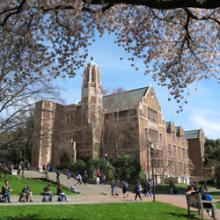From 1927 to 1950, music classes at the University of Washington were held in a wooden frame building erected in 1909 for the Alaska-Yukon-Pacific Exposition and for a time used as the home of the University President. But on June 1, 1950, the School of Music took up residence in a new, five-story, state-of-the-art building at the head of the Arts and Sciences Quadrangle, the final building constructed in that iconic location.
By that time, enrollment in music classes at UW had topped 2,400 students. “It is evident that members of the faculty carry on a tremendous amount of teaching, as well as their extra activities in the way of public performance, composition, writings regarding music, research, and other forms of service to the community and state,” wrote Music Professor Hazel Kinscella in an unpublished 1951 history of the School of Music.
The new building, designed by Whitehouse and Price of Spokane and constructed at a cost of nearly $2 million, boasted a 275-capacity student recital hall, 36 soundproofed practice rooms, an elevator to transport pianos from floor to floor, a small motion picture theater, five broadcasting studios and rehearsing halls, and classrooms for music appreciation courses.
“A fine listening room, furnished with all modern facilities, has brought to the student body an unusual opportunity to acquaint itself, at leisure, with the masterpieces of musical literature,” Kinscella wrote. “The band, orchestra, and broadcast-reproducing rooms in the sub-basement are considered by architects to be the finest of their kind in the country. Classrooms, offices, and practice rooms are acoustically treated.”
The new building also contained space for a departmental library, which devoted a small alcove to an Americana Music Center, housing Professor Kinscella’s collection of pioneer-era musical artifacts. A feature published in the Seattle Times on March 4, 1951 noted that the Kinscella Collection included a melodeon, or “baby organ” made by Mason & Hamlin in 1869 as well as books, copies of Dwights’ Journal (the first musical magazine in America), original manuscripts of American composers, miniature scores, photostatic copies of colonial music, and other items.
In 2012, the Music Building retains the strong Gothic lines of its earliest architectural renderings. From the outside, at least, the structure appears to be identical to when it first opened in 1950. Inside, various modifications have been made, most notably the creation in the late 1970s of a wing of offices and labs that once accommodated the Systematic Musicology program and now house faculty and staff for Music Education and Ethnomusicology. That annex, on the east ground level of the building, was created by lopping off the top of the former motion picture theater, now known as Music Room 35, a rehearsal and classroom space used by various Music performance programs. Students still conduct research in the Music Library on the building’s main floor, still rehearse until late into the night in the practice rooms on the second and third floors, and attend a wide variety of classes all throughout the building. And virtually every day of the year, passersby may hear the sound of music ringing out from the practice rooms and studios across the Arts and Sciences Quadrangle, just as they have all day, nearly every day, for the past sixty-plus years.
